

Rett syndrome drug shows promise in clinical trial. Rett syndrome, a rare genetic disorder that causes mental retardation, autism, and physical deformities, has no cure.
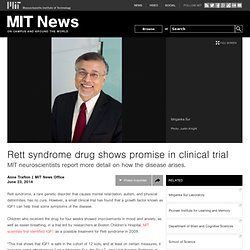
However, a small clinical trial has found that a growth factor known as IGF1 can help treat some symptoms of the disease. Children who received the drug for four weeks showed improvements in mood and anxiety, as well as easier breathing, in a trial led by researchers at Boston Children’s Hospital. Rett Syndrome Research Trust Blog. By Katie Bowers and Monica Coenraads Sometimes, new ideas come from the strangest of places; inspired by something that seems completely unrelated.

This sort of out-of-the-blue brain blast is exactly what happened in 2012 when a study about bacteria’s adaptive immunity opened up the possibility for a new approach to gene therapy. While CRISPR technology was runner-up for the Breakthrough Technology of the Year in 2012, its presence in bacteria cells has been known since 1987. It was not until a series of studies between 2005 and 2007, however, that their role in the bacterial adaptive immunity was revealed. Short for Clustered Regularly Interspaced Short Palindromic Repeats; a CRISPR is a small length of DNA with a repeating and reversing sequence of base pairs (the pieces that make up genetic code).
When pathogens, such as a virus, attack bacteria they insert a section of DNA into their victim. How do bacteria do this? RSRT Launches the MECP2 Gene Therapy Consortium with a $1.6 Million Investment. By Monica Coenraads [Italian translation] [Spanish translation] [Press release] The videos below are perhaps the most well-known in the Rett community.
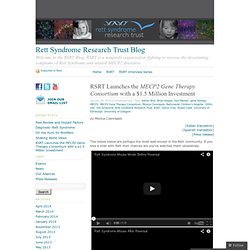
If you love a child with Rett then chances are you’ve watched them obsessively. This work published in 2007 by Adrian Bird, declared to the world that Rett is reversible, but did not tell us how this could be done in people. Fast-forward six years and the video below from the RSRT-funded labs of Gail Mandel and Adrian Bird may have given us an answer: gene therapy. The mouse moving around was given gene therapy treatment and received healthy Mecp2 gene. So how do we make the giant leap from recovered mice to recovered children? To move us towards this goal, RSRT has launched their second collaborative group – the MECP2 Gene Therapy Consortium.
I recently caught up with the investigators to discuss this novel collaboration: Brian Kaspar (Nationwide Children’s Hospital) Currently working on gene therapy clinical trial for Spinal Muscular Atrophy. Prof. Adrian Bird Comments on Rett Syndrome Reversal. Cognitive deficits in Rett syndrome: wha... [Neurobiol Learn Mem. 2011.
Rett syndrome sees glimmer of hope in Phase I trial. This post is the first in a two-part series on clinical trials in autism spectrum disorders.

Read part 2. In the world of neurodevelopmental disorders, an exciting trend is the emergence of specific molecular targets and treatments through genetic research. A case in point is IGF-1 therapy for Rett syndrome, a devastating disorder in girls that affects their ability to speak, walk, eat and breathe. It causes autism-like behaviors, intellectual disability and repetitive hand-wringing movements—a hallmark of the disorder. A Phase I trial, published this week in the Proceedings of the National Academy of Sciences Early Edition, has modest but consistent results suggesting improvements in some salient features of the disorder.
Current treatments for Rett syndrome address only the symptoms and comorbidities, such as seizures, anxiety and scoliosis, but not the disease itself. The paper had an impact around the world. There were other improvements as well. Reference strains aid genetic testing for Rett syndrome. Genetic testing: Tests for Rett syndrome need to detect the hundreds of different mutations seen in MeCP2 in people with the syndrome.
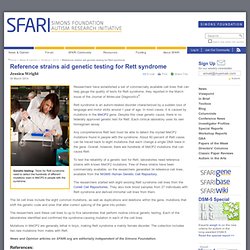
Researchers have established a set of commercially available cell lines that can help gauge the quality of tests for Rett syndrome, they reported in the March issue of the Journal of Molecular Diagnostics1. Rett syndrome is an autism-related disorder characterized by a sudden loss of language and motor skills around 1 year of age. In most cases, it is caused by mutations in the MeCP2 gene. Despite this clear genetic cause, there is no federally approved genetic test for Rett. Each clinical laboratory uses its own homegrown assay. Molecular mechanisms: Mutant star cells stunt neuron size. Two sides: Researchers have generated both normal (top) and mutant (bottom) astrocytes (green) from individuals with mutations linked to Rett syndrome.
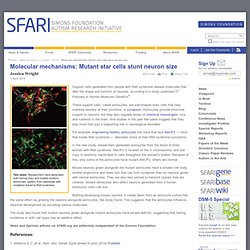
Support cells generated from people with Rett syndrome release molecules that alter the shape and function of neurons, according to a study published 27 February in Human Molecular Genetics1. These support cells, called astrocytes, are star-shaped brain cells that help stabilize neurons at their junctions, or synapses. Astrocytes provide structural support to neurons, but they also regulate levels of chemical messengers, ions and nutrients in the brain. Rett syndrome sees glimmer of hope in Phase I trial. April: Rett syndrome research. Welcome to the RSRT Blog. RSRT is a nonprofit organization fighting to reverse the devastating symptoms of Rett Syndrome and related MECP2 disorders. Neurons that inhibit brain signals are key in Rett syndrome.
Deleting MeCP2 from a subset of neurons that mediate inhibitory signals recapitulates many of the symptoms of Rett syndrome in mice.
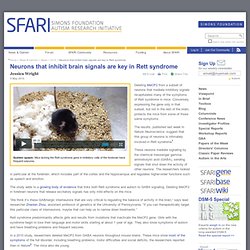
Conversely, expressing the gene only in that subset, but not in the rest of the brain, protects the mice from some of those same symptoms. The results, published last week in Nature Neuroscience, suggest that this group of neurons is intimately involved in Rett syndrome1. These neurons mediate signaling by the chemical messenger gamma-aminobutyric acid (GABA), sending signals that shut down the activity of other neurons.
The researchers looked in particular at the forebrain, which includes part of the cortex and the hippocampus and regulates higher-order functions such as speech and emotion. Existing drugs could treat Rett syndrome, studies suggest. Forbidden benefits: Clenbuterol, an asthma drug that some people take off-label to build muscle, may treat symptoms of Rett syndrome.

Rett syndrome affects many cellular pathways, but correcting just one of these with drugs approved for other purposes may be enough to alleviate symptoms of the disorder. This was the message from two presentations Tuesday at the 2013 Society for Neuroscience annual meeting in San Diego. One study showed that restoring a healthy copy of MeCP2, the gene mutated in the syndrome, in just 20 percent of the brain’s neurons improves most symptoms in mice. The second delves into a growth factor pathway already being used to treat Rett syndrome, looking for additional nodes that are amenable to treatment. Rett syndrome primarily affects girls, who have problems with motor skills, breathing and language starting at around 2 years of age. In fact, the experiment worked extremely well. IGF1 and clenbuterol can also be used in combination, Mellios found.
Cognition and behavior: Mouse models human Rett mutation. A mouse model of Rett syndrome that mimics a mutation seen in people has many of the behavioral features of the disorder, such as hand clasping, according to a study published 27 November in Nature Neuroscience1.
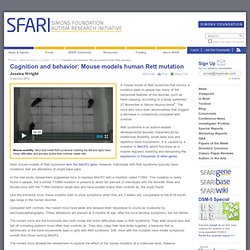
The mice also have brain abnormalities that suggest a decrease in connectivity compared with controls. Rett syndrome is an autism-related developmental disorder characterized by intellectual disability, small head size and repetitive hand movements. It is caused by a mutation in MeCP2, which functions as a master regulator, boosting and dampening the expression of thousands of other genes. Researchers debut new mouse model for Rett syndrome. Mutant mouse: The new model for Rett syndrome recapitulates nearly all features of the syndrome, including compulsive clasping of forepaws and over-grooming.

A new mouse model for Rett syndrome shows that disrupting a single brain messenger can produce nearly all of the characteristic features of the syndrome, researchers report today in Nature1. The work implicates the molecule, gamma-aminobutyric acid (GABA), in autism and other disorders. GABA is an 'inhibitory' neurotransmitter, meaning that it turns off neural circuits.
The brain has fewer cells that release GABA than those that release excitatory neurotransmitters, but the GABA-releasing cells may play a disproportionately important role. "These neurons are really important for [understanding] neuropsychiatric symptoms," says lead investigator Huda Zoghbi, professor of pediatrics and neurology at Baylor College of Medicine in Houston, Texas. Unconditional effects: Rett Syndrome Research Trust Blog. By Monica Coenraads There is no mystery about why a girl suffers from Rett Syndrome. The cause is the mutated copy of the MECP2 gene inhabiting her cells. But since MECP2 is on the X chromosome and all females have two X’s, beside each mutated gene rests a healthy but silenced twin. What if we could replace the flawed gene by reawakening its silenced counterpart? If we could wake up MECP2 in enough cells we could conceivably reverse Rett symptoms. This is an approach that RSRT has championed since our launch in 2008.
You may ask why do we need multiple labs working on the same goal. For example, the types of cells that labs are utilizing are different. 037: Dr. Lucas Pozzo-Miller: Exploring the Pathway Less Traveled to Better Understand Rett Syndrome. Podcast: Play in new window | Download Listen Free in iTunes Listen Free on Stitcher Radio Dr. Pinpointing brainstem mechanisms responsible for autonomic dysfunction in Rett syndrome: therapeutic perspectives for 5-HT1A agonists.